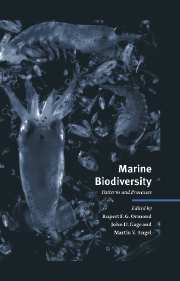Book contents
- Frontmatter
- Contents
- List of contributors
- Foreword: The value of diversity
- 1 Marine biodiversity in its global context
- 2 Gradients in marine biodiversity
- 3 Pelagic biodiversity
- 4 Biological diversity in oceanic macrozooplankton: More than counting species
- 5 Large-scale patterns of species diversity in the deep-sea benthos
- 6 Diversity, latitude and time: Patterns in the shallow sea
- 7 High benthic species diversity in deep-sea sediments: The importance of hydrodynamics
- 8 Diversity and structure of tropical Indo-Pacific benthic communities: Relation to regimes of nutrient input
- 9 Why are coral reef communities so diverse?
- 10 The biodiversity of coral reef fishes
- 11 The historical component of marine taxonomic diversity gradients
- 12 Population genetics and demography of marine species
- 13 Discovering unrecognised diversity among marine molluscs
- 14 Ecosystem function at low biodiversity – the Baltic example
- 15 Land–seascape diversity of the USA East Coast coastal zone with particular reference to estuaries
- 16 The development of mariculture and its implications for biodiversity
- 17 Protecting marine biodiversity and integrated coastal zone management
- 18 Conserving biodiversity in North-East Atlantic marine ecosystems
- Author index
- Species index
- Subject index
10 - The biodiversity of coral reef fishes
Published online by Cambridge University Press: 04 August 2010
- Frontmatter
- Contents
- List of contributors
- Foreword: The value of diversity
- 1 Marine biodiversity in its global context
- 2 Gradients in marine biodiversity
- 3 Pelagic biodiversity
- 4 Biological diversity in oceanic macrozooplankton: More than counting species
- 5 Large-scale patterns of species diversity in the deep-sea benthos
- 6 Diversity, latitude and time: Patterns in the shallow sea
- 7 High benthic species diversity in deep-sea sediments: The importance of hydrodynamics
- 8 Diversity and structure of tropical Indo-Pacific benthic communities: Relation to regimes of nutrient input
- 9 Why are coral reef communities so diverse?
- 10 The biodiversity of coral reef fishes
- 11 The historical component of marine taxonomic diversity gradients
- 12 Population genetics and demography of marine species
- 13 Discovering unrecognised diversity among marine molluscs
- 14 Ecosystem function at low biodiversity – the Baltic example
- 15 Land–seascape diversity of the USA East Coast coastal zone with particular reference to estuaries
- 16 The development of mariculture and its implications for biodiversity
- 17 Protecting marine biodiversity and integrated coastal zone management
- 18 Conserving biodiversity in North-East Atlantic marine ecosystems
- Author index
- Species index
- Subject index
Summary
Abstract
Reef fish show patterns of distribution and diversity at all scales, from global to regional to local. At the largest scale diversity appears to be principally controlled by the interaction of tectonic and geomorphological events with evolutionary and dispersion processes. At a regional level, water column characteristics such as turbidity and current strength, perhaps requiring differential adaptation at the larval stage, may control species distribution patterns. At a local level, diversity is influenced by habitat characteristics such as depth, heterogeneity and complexity. Because of the vagaries of larval distribution and recruitment, the assemblages to be found at a site are quite variable, although the extent of this variation probably differs among species and areas. It is not clear that stochasticity per se promotes local or regional diversity, but the fact that currents must frequently carry larvae of a species from areas where it is a superior competitor to ones where it is an inferior competitor seems very likely to do so. But regarding the tantalising issue of the high biodiversity of reef fishes – ‘why is it that the species richness of coral reef fish assemblages is so high?’ – we have no clear answer. There are various plausible mechanisms, but as yet no conclusive evidence to indicate their relative importance. However, efforts to conserve coral reefs and coral reef fishes should not be delayed by such lack of full understanding.
- Type
- Chapter
- Information
- Marine BiodiversityPatterns and Processes, pp. 216 - 257Publisher: Cambridge University PressPrint publication year: 1997
- 16
- Cited by



